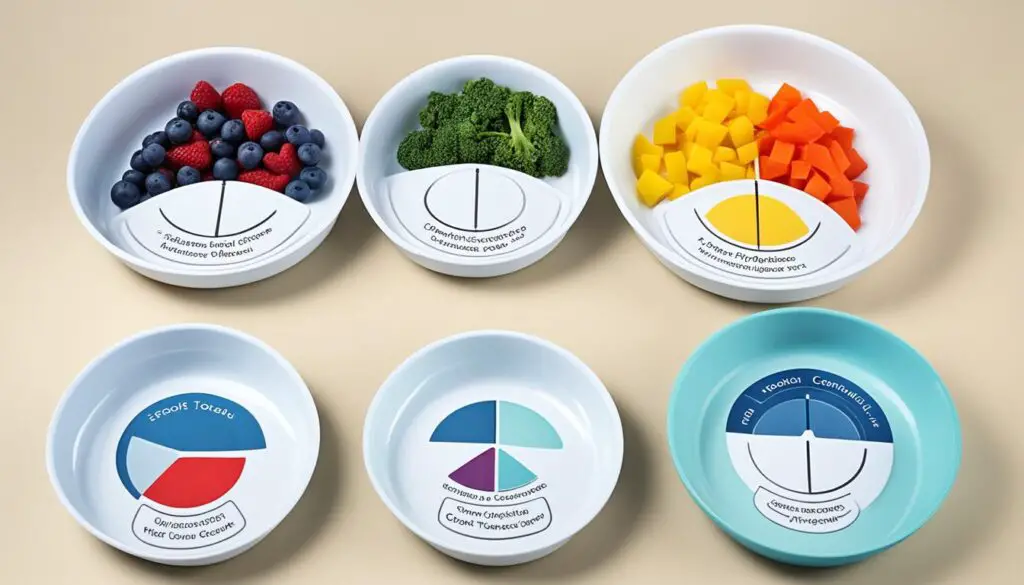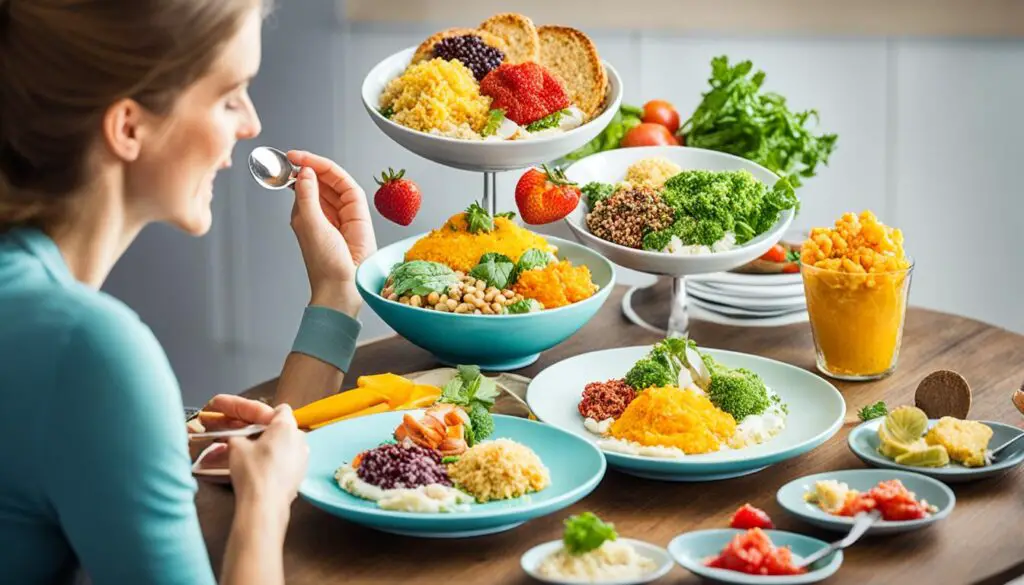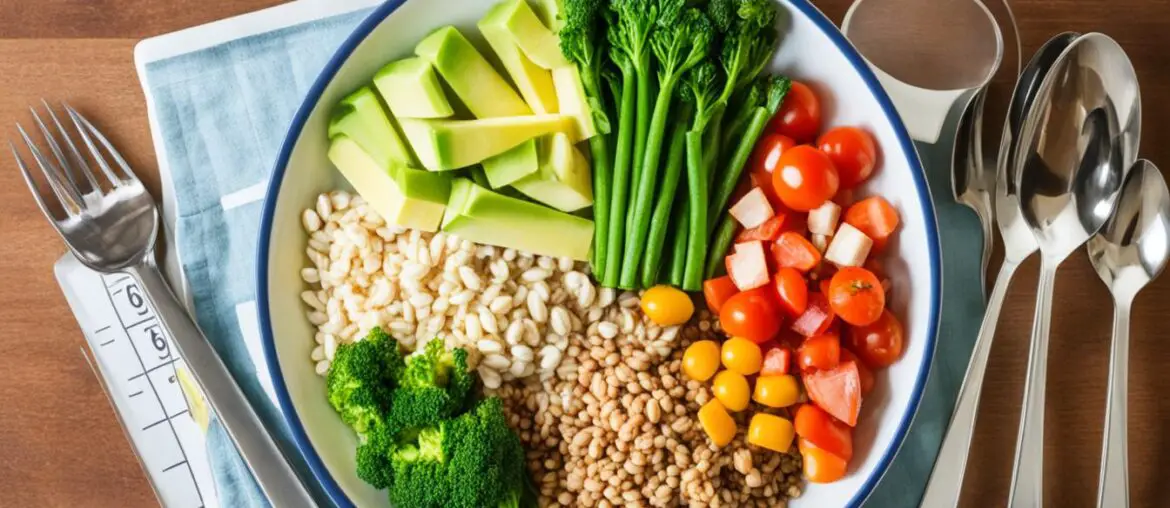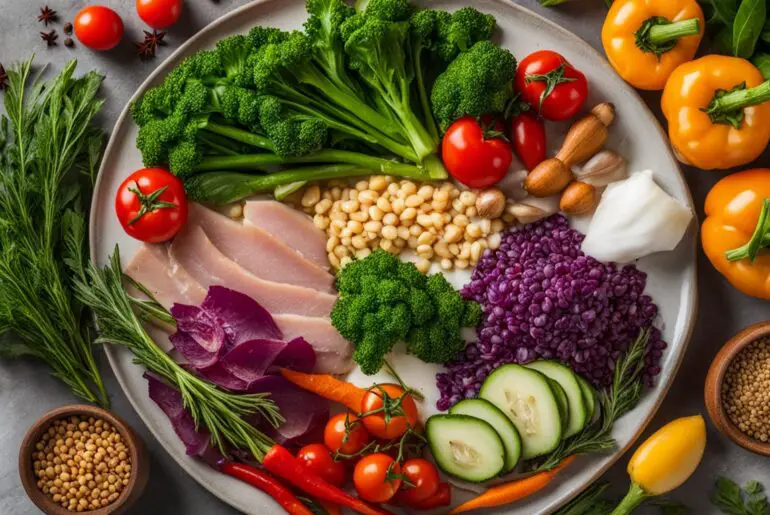Did you know that the HCG diet, a controversial weight loss plan, requires individuals to consume either 500 or 800 calories per day during the weight loss phase? That’s equivalent to less than half the recommended daily caloric intake for most adults! But what happens after completing the HCG injections or supplements? That’s where portion control comes in.
During the maintenance phase of the HCG diet, also known as the post-diet phase, it is crucial to practice portion control to maintain the weight loss achieved during the low-calorie phase. This article will explore the importance of portion control, provide tips for implementing it effectively, and discuss additional strategies for sustainable weight management.
Key Takeaways:
- Portion control is vital after completing the HCG diet to sustain weight loss.
- Measuring food, including plenty of vegetables, using smaller plates, and planning meals are effective portion control techniques.
- Other strategies for sustainable weight management include maintaining an active lifestyle, focusing on nutrient-dense foods, staying hydrated, and seeking professional guidance.
- Meal planning and mindful eating can help with portion control and promote balanced eating habits.
- Building a sustainable lifestyle with healthy eating habits is crucial for long-term weight management after the HCG diet.
Understanding the HCG Diet and its Phases
The HCG diet is a weight loss program that consists of three phases: the loading phase, the weight loss phase, and the maintenance phase. Each phase plays a crucial role in the overall effectiveness of the diet.
The Loading Phase
In the loading phase, individuals consume high-calorie foods for two days while taking HCG hormone supplements or injections. This phase helps prepare the body for the low-calorie diet that follows and ensures the body has enough stored energy to sustain it during the weight loss phase.
The Weight Loss Phase
The weight loss phase is the most challenging part of the HCG diet. It involves consuming either 500 or 800 calories per day while continuing to take the HCG hormone. This low-calorie diet, combined with the hormone, triggers the body to burn stored fat for energy instead of relying on calories from food. It is important to strictly adhere to the recommended calorie intake and HCG dosage during this phase to achieve optimal results.
During the weight loss phase, individuals typically experience significant weight loss, with an average of 1-2 pounds per day. It is essential to monitor progress and make adjustments as necessary to ensure safety and effectiveness.
The Maintenance Phase
The maintenance phase is the final stage of the HCG diet, where individuals transition back to regular eating while maintaining portion control. This phase is crucial for maintaining the weight loss achieved during the previous phases and establishing healthier eating habits. It typically lasts for three weeks after completing the weight loss phase.
During the maintenance phase, individuals gradually increase their calorie intake while still avoiding high-sugar and high-carbohydrate foods. The goal is to stabilize and maintain the new weight by retraining the body’s metabolism and establishing a healthy relationship with food.
It is important to note that the HCG hormone used in the diet is controversial and not approved by the FDA for weight loss. It is essential to consult with a healthcare professional before starting any new diet or weight loss program.
Importance of Portion Control After the HCG Diet

Portion control plays a vital role in maintaining weight loss and preserving healthy eating habits after completing the HCG diet. By practicing portion control, individuals can achieve sustainable weight management and maintain a balanced diet.
One of the key benefits of portion control is preventing overeating. After the HCG diet, it’s essential to be mindful of the quantity of food consumed. By controlling portion sizes, individuals can avoid the risk of weight regain and ensure the long-term success of their weight loss journey.
Adopting healthy eating habits is another critical aspect of post-diet life. Portion control serves as a tool to create a balanced diet, ensuring individuals receive the necessary nutrients while managing calorie intake. By controlling portions, individuals can enjoy a wide range of foods and maintain a nutritious eating plan.
Consistency is key when it comes to portion control. By practicing portion control consistently, individuals can develop healthy habits that become second nature. These habits contribute to long-term weight management and sustainable lifestyle changes.
It’s important to note that portion control should be approached with a sense of moderation, balance, and mindfulness. It is not about restrictive eating or cutting out entire food groups. Instead, it’s about finding a healthy balance that works for each individual’s unique needs and preferences.
By prioritizing portion control, individuals can create a sustainable lifestyle that supports their weight management goals and promotes overall well-being.
Benefits of Portion Control after the HCG Diet:
- Promotes sustainable weight management
- Fosters healthy eating habits
- Enables a balanced diet
- Prevents overeating and weight regain
- Supports long-term success in maintaining weight loss
By incorporating portion control into daily life, individuals can achieve and sustain their desired weight goals while enjoying a varied and fulfilling diet.
| Portion Control Tips | Benefits |
|---|---|
| Use smaller plates and bowls | Helps control portion sizes and prevents overeating |
| Measure your food | Ensures accurate portion sizes and calorie control |
| Fill half of your plate with vegetables | Increases nutrient intake while reducing calorie consumption |
| Plan your meals | Aids in portion control and promotes healthier food choices |
| Eat mindfully | Enhances enjoyment of food, aids in recognizing hunger and fullness cues |
Tips for Portion Control After the HCG Diet
https://www.youtube.com/watch?v=9Fyxo9fhsVc
After completing the HCG diet and achieving your weight loss goals, it’s important to continue practicing portion control to maintain your progress and support a healthy lifestyle. Here are some tips to help you with post-diet portion control:
- Measure your food: Using measuring cups or a food scale can help you accurately portion your meals. This ensures that you’re not unintentionally consuming larger portions than necessary.
- Fill half of your plate with vegetables: Vegetables are low in calories and high in nutrients, making them an excellent choice for portion control. By filling half of your plate with veggies, you create a visual cue that encourages healthier portion sizes.
- Use smaller plates and bowls: Trick your brain into thinking you’re eating more by using smaller dishes. The smaller plate size can create the illusion of a fuller plate, helping you feel satisfied with smaller portions.
- Plan your meals: Meal planning is a helpful strategy for portion control. By planning your meals in advance, you can ensure that you’re making healthier choices and controlling portion sizes. Consider incorporating a variety of nutrient-rich foods to maintain a balanced diet.
- Eat mindfully: Pay attention to your body’s hunger and fullness cues to avoid overeating. By slowing down while eating, savoring each bite, and taking the time to enjoy your meals, you can better listen to your body’s signals and prevent overindulgence.
By implementing these portion control tips into your post-HCG-diet routine, you can continue making progress towards your health and weight management goals.
Sample Table:
| Portion Control Tip | Explanation |
|---|---|
| Measure your food | Using measuring cups or a food scale helps you accurately portion your meals. |
| Fill half of your plate with vegetables | Vegetables are low in calories and high in nutrients, making them an excellent choice for portion control. |
| Use smaller plates and bowls | Using smaller dishes tricks your brain into thinking you’re eating more, helping you feel satisfied with smaller portions. |
| Plan your meals | Meal planning allows you to make healthier choices and control portion sizes. |
| Eat mindfully | Pay attention to your body’s hunger and fullness cues, and slow down while eating to prevent overeating. |
Strategies for Sustainable Weight Management

After completing the HCG diet, it’s important to implement strategies that support sustainable weight management and promote balanced eating habits. In addition to practicing portion control, there are other key post-diet strategies that can help you maintain your weight loss and lead a healthy lifestyle.
- Maintain an active lifestyle: Regular exercise is crucial for weight maintenance and overall health. Aim to engage in activities that you enjoy, such as walking, jogging, cycling, or attending fitness classes. Find ways to stay active throughout the day, whether it’s taking the stairs instead of the elevator or going for a walk during your lunch break.
- Focus on nutrient-dense foods: Fill your plate with foods that are rich in nutrients and low in calories. Incorporate plenty of fruits, vegetables, lean proteins, whole grains, and healthy fats into your meals. These nutrient-dense foods will not only provide you with essential vitamins and minerals but also help you stay satisfied and energized.
- Stay hydrated: Drinking an adequate amount of water is essential for weight management. Water helps control hunger and cravings, and it supports proper digestion and metabolism. Aim to drink at least eight glasses of water per day, and consider replacing sugary beverages with water or unsweetened herbal tea.
- Seek professional guidance: Consulting with a registered dietitian or nutritionist can provide you with personalized recommendations and support on your post-diet journey. They can help you create a customized meal plan, address any specific dietary needs or concerns, and offer valuable advice for long-term weight management.
By implementing these post-diet strategies, you can establish a sustainable lifestyle that promotes balanced eating habits and supports your weight management goals. Remember, it’s important to find strategies that work best for you and align with your individual needs and preferences. With dedication and persistence, you can maintain your weight loss and enjoy a healthier, happier life.
Meal Planning for Portion Control After the HCG Diet
Meal planning is an essential strategy for maintaining portion control after completing the HCG diet. By pre-planning your meals, you can ensure that you consume the appropriate portions and make balanced food choices. This allows you to sustain a healthy diet and prevent overeating. To create a well-rounded meal plan, incorporate a variety of fruits, vegetables, lean proteins, and whole grains.
By including these nutritious food groups in your meal plan, you can meet your body’s nutritional needs and maintain a balanced diet. This is crucial for post-diet meal planning to support sustainable weight management and overall well-being.
Benefits of Meal Planning for Portion Control
Meal planning is a powerful tool to help you stay on track with your portion control goals after the HCG diet. It allows you to:
- Make deliberate and conscious food choices
- Control your calorie intake effectively
- Reduce the temptation to deviate from your portion control strategies
- Easily manage your grocery shopping and food preparation
- Save time and effort in deciding what to eat
Through meal planning, you proactively set yourself up for success in maintaining the progress you achieved during the HCG diet. It empowers you to take charge of your nutrition and portion sizes, ensuring continued results and a sustainable healthy lifestyle.
| Meal | Food Group | Portion Size |
|---|---|---|
| Breakfast | Whole grain cereal | 1 cup |
| Fruit (e.g., berries) | 1/2 cup | |
| Low-fat milk | 1 cup | |
| Lunch | Grilled chicken breast | 3 ounces |
| Mixed vegetables | 1 cup | |
| Brown rice | 1/2 cup | |
| Snack | Greek yogurt | 6 ounces |
| Almonds | 1 ounce | |
| Fresh fruit | 1 medium piece | |
| Dinner | Salmon fillet | 4 ounces |
| Steamed broccoli | 1 cup | |
| Quinoa | 1/2 cup |
Remember, this sample meal plan is just an example and can be customized to fit your individual needs and preferences. It provides a template for incorporating various food groups and controlling portion sizes to support your post-diet portion control strategies.
By meal planning and adhering to appropriate portion sizes, you can continue to enjoy a satisfying and nutritious diet while maintaining your desired weight.
Portion Control Techniques and Tools

After completing the HCG diet, maintaining portion control is crucial for long-term weight management and healthy eating habits. Fortunately, there are various techniques and tools available to assist you in this journey.
Using Smaller Plates and Bowls
One effective technique is to switch to smaller plates and bowls for your meals. Research has shown that people tend to eat less when their food is served on smaller plates, as it creates a visual illusion of a fuller plate. By using smaller dishware, you can naturally control your portion sizes without feeling deprived.
Measuring Cups and Spoons
Another helpful tool for portion control is the use of measuring cups and spoons. By accurately measuring your food, you can ensure that you are consuming the recommended portion sizes. This is especially important when it comes to calorie-dense foods like grains, oils, and nuts.
Dividing Your Plate into Food Groups
An effective technique for portion control is to divide your plate into food groups. The MyPlate method, developed by the U.S. Department of Agriculture, suggests filling half of your plate with fruits and vegetables, one-fourth with lean proteins, and one-fourth with whole grains. This visual cue helps you balance your meal and control portion sizes.
Estimating Portion Sizes with Visual Cues
If you don’t have measuring cups or spoons available, you can use visual cues to estimate portion sizes. For example, your hand can serve as a handy portion control tool. Your palm represents a serving of protein, your fist represents a serving of vegetables, your cupped hand represents a serving of carbohydrates, and your thumb represents a serving of fats or oils.
| Portion Control Technique/Tool | Description |
|---|---|
| Smaller Plates and Bowls | Switching to smaller dishware creates a visual illusion of a fuller plate, helping you control portion sizes naturally. |
| Measuring Cups and Spoons | Using measuring cups and spoons allows for accurate portion measurements and prevents overeating. |
| Dividing Your Plate into Food Groups | Allocating your plate space to different food groups helps ensure balanced meals and controlled portion sizes. |
| Estimating Portion Sizes with Visual Cues | Using your hand or other visual cues can help estimate portion sizes when precise measurements are not available. |
By implementing these portion control techniques and utilizing the appropriate tools, you can maintain a balanced diet, achieve sustainable weight management, and support your long-term health goals.
Mindful Eating for Portion Control

Practicing mindful eating can be incredibly beneficial for maintaining portion control after the HCG diet. Mindful eating involves being fully present and aware of the food you consume, savoring each bite, and eating slowly. By practicing mindfulness, you can tune in to your body’s hunger and fullness cues, preventing overeating and promoting balanced eating habits.
When practicing mindful eating, it’s important to pay attention to the sensations, flavors, and textures of each bite. Take the time to truly savor your food, chewing slowly and thoroughly. Avoid distractions such as screens or other activities while eating, as this can lead to mindless overeating.
One helpful technique for practicing mindful portion control is to use smaller plates or bowls. By using smaller dinnerware, you can visually trick yourself into thinking you’re consuming a larger portion. This can help satisfy your psychological need for a full plate while still controlling the amount of food you consume.
In addition to portion sizes, practicing mindful eating can also help you become more attuned to your body’s hunger and fullness signals. Before each meal, take a moment to check in with yourself and assess if you’re truly hungry or if you’re eating out of habit or emotional reasons. Eating only when you’re genuinely hungry can help prevent unnecessary snacking and overeating.
Mindful eating is not only beneficial for portion control, but it also promotes a healthier relationship with food. By practicing mindfulness, you can become more mindful of your food choices and make more balanced and nutritious decisions. This can contribute to your overall well-being and long-term weight management.
The Benefits of Mindful Eating for Portion Control
Mindful eating can help control portion sizes and prevent overeating. By being fully present and attentive while eating, you can tune in to your body’s hunger and fullness cues, leading to a more balanced and controlled approach to portion sizes.
Tips for Practicing Mindful Eating
- Eat without distractions: Eliminate distractions such as screens or work during mealtimes to fully focus on your food.
- Chew slowly and thoroughly: Take the time to thoroughly chew each bite, savoring the flavors and textures of your food.
- Listen to your body: Pay attention to your body’s hunger and fullness signals. Stop eating when you feel comfortably satisfied, rather than stuffed.
- Engage your senses: Notice the colors, smells, and tastes of your food, enhancing your sensory experience.
- Practice gratitude: Take a moment before each meal to express gratitude for the food on your plate, cultivating a positive mindset.
By incorporating mindful eating into your post-HCG diet routine, you can continue to prioritize portion control and maintain a healthy lifestyle.
Building a Sustainable Lifestyle After the HCG Diet

After completing the HCG diet, it is important to focus on building a sustainable lifestyle that promotes balanced eating habits and long-term weight management.
One of the key aspects of maintaining a sustainable lifestyle is practicing portion control. By monitoring your food intake and being mindful of portion sizes, you can ensure that you are consuming the right amount of calories to support your weight management goals. This includes being aware of portion sizes when dining out and using measuring cups or a food scale to accurately portion your meals.
Regular exercise is another essential component of a sustainable lifestyle. Incorporating physical activity into your daily routine not only helps with weight management, but also improves overall health and well-being. Find activities that you enjoy, such as walking, jogging, cycling, or dancing, and make it a priority to engage in them regularly.
In addition to portion control and exercise, making healthy food choices is crucial for sustaining your weight loss. Focus on incorporating nutrient-dense foods into your diet, such as fruits, vegetables, lean proteins, and whole grains. These foods provide essential vitamins, minerals, and fiber while being lower in calories.
Meal planning can be an effective strategy for maintaining a balanced eating habit. Plan your meals in advance, ensuring that they include a variety of nutritious ingredients. This not only helps control portion sizes but also prevents impulsive or unhealthy food choices.
Weight Management Strategies
- Stay hydrated: Drinking an adequate amount of water can help control hunger and prevent overeating. Aim to consume at least 8 cups of water per day.
- Manage stress: Chronic stress can contribute to weight gain. Find healthy ways to manage stress, such as exercise, meditation, or engaging in activities you enjoy.
- Get enough sleep: Lack of sleep can disrupt hormones that regulate appetite and contribute to weight gain. Aim for 7-9 hours of quality sleep each night.
- Seek support: Surround yourself with a supportive network of friends, family, or a weight loss community. Having others who share your goals can provide motivation and accountability.
Remember, building a sustainable lifestyle is a long-term commitment. It requires dedication, consistency, and the willingness to make healthy choices every day. By incorporating portion control, regular exercise, and balanced eating habits into your daily routine, you can achieve long-term success in maintaining your weight loss and overall well-being.
Conclusion
In conclusion, practicing portion control is crucial for maintaining weight loss and promoting a healthy lifestyle after completing the HCG diet. By controlling your portions, you can prevent overeating and ensure that you continue to make progress in your weight management journey. Incorporating healthy eating habits and building a sustainable lifestyle are also key factors in long-term success.
Remember, achieving balanced eating and sustainable weight management requires consistency and dedication. It’s important to consult with a healthcare professional or registered dietitian who can provide personalized guidance and support tailored to your specific needs and goals. They can help you create a customized plan that takes into account your dietary preferences, lifestyle, and any underlying health conditions.
Key takeaways from this article include the importance of portion control, the benefits of practicing mindful eating, and the significance of incorporating nutritious, whole foods into your diet. Implementing strategies such as meal planning and using portion control tools can also aid in your post-diet journey. Ultimately, by adopting these practices and building a sustainable lifestyle, you can achieve long-term weight management and improve your overall well-being.
FAQ
What is the HCG diet and its phases?
The HCG diet is a weight loss plan that combines HCG supplements or hormone injections with an extremely low-calorie diet. It consists of three phases: the loading phase, the weight loss phase, and the maintenance phase.
Why is portion control important after the HCG diet?
Portion control is crucial after completing the HCG diet to ensure sustainable weight management and promote healthy eating habits. It helps maintain a balanced diet and prevents overeating, which can lead to weight regain.
What are some tips for practicing portion control after the HCG diet?
Some tips for practicing portion control after the HCG diet include measuring your food, filling half of your plate with vegetables, using smaller plates and bowls, planning your meals, and eating mindfully.
What strategies can aid in sustainable weight management after the HCG diet?
Strategies for sustainable weight management after the HCG diet include maintaining an active lifestyle, focusing on nutrient-dense foods, staying hydrated, and seeking professional guidance.
How can meal planning help with portion control after the HCG diet?
Meal planning is an effective strategy for portion control after the HCG diet. It allows you to control portion sizes and make balanced food choices by including a variety of fruits, vegetables, lean proteins, and whole grains in your meals.
What techniques and tools can help with portion control after the HCG diet?
Techniques and tools that can help with portion control after the HCG diet include using smaller plates and bowls, measuring cups and spoons, dividing your plate into food groups, and using visual cues such as your hand or a deck of cards to estimate portion sizes.
How can mindful eating aid in portion control after the HCG diet?
Mindful eating involves paying attention to your food, savoring each bite, and eating slowly. It helps you tune into your body’s hunger and fullness cues, preventing overeating and promoting balanced eating habits.
What should I focus on to build a sustainable lifestyle after the HCG diet?
To build a sustainable lifestyle after the HCG diet, focus on maintaining portion control, incorporating regular exercise, and making healthy food choices a part of your daily routine.




